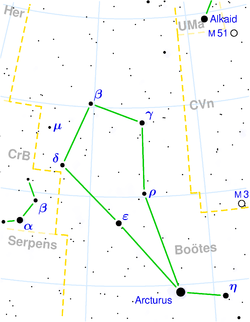De Wikipedia, la enciclopedia libre
«Arcturus» redirige aquí. Para la banda noruega de black metal/avant-garde, véase Arcturus (banda).
| Arturo |

Ubicación de Arturo en la constelación de Boötes. |
Datos de observación
(Época J2000.0) |
| Constelación |
Boötes |
| Ascensión recta (α) |
14h 15m 39,67s |
| Declinación (δ) |
+19° 10′ 56,7″ |
| Mag. aparente (V) |
−0,04 |
| Características físicas |
| Clasificación estelar |
K1.5III |
| Masa solar |
1 – 1,5 M☉ |
| Radio |
(25,7 ± 0,3[1] R☉) |
| Índice de color |
1,24 (B-V)
1,22 (U-B) |
| Magnitud absoluta |
−0,29 |
| Luminosidad |
215[2] L☉ |
| Temperatura superficial |
4.290 K |
| Metalicidad |
20 – 50% del Sol |
| Variabilidad |
Posible |
| Edad |
> 4,6 × 109 |
| Astrometría |
| Mov. propio en α |
−1093,45 mas/año |
| Mov. propio en δ |
−1999,40 mas/año |
| Velocidad radial |
−5,2 km/s |
| Distancia |
36,7 ± 0,3 años luz |
| Paralaje |
88,78 ± 0,68 mas |
| Referencias |
| SIMBAD |
enlace |
| Otras designaciones |
| Aramec, Abramech, α Boötis, 16 Boötis, HD 124897, HR 5340, BD+19°2777, GCTP 3242.00, GJ 541, LHS 48, y HIP 69673 |
Arturo o Arcturus (Alfa Bootis / α Boo / 16 Bootis) es la tercera estrella más brillante del cielo nocturno con una magnitud visual de -0,04, después de Sirio (α Canis Majoris) y Canopus (α Carinae); considerando juntas las dos componentes principales de Alfa Centauri, que no se pueden resolver a simple vista, Arturo pasa a ser la cuarta estrella más brillante. Se trata, por lo tanto, de la estrella más brillante del hemisferio celeste norte. Su constelación es Boötes, «El Boyero». Se encuentra en la Nube Interestelar Local.
[editar] Etimología e historia

Forma de encontrar a
Arturo en el cielo, a partir de la Osa Mayor.
El nombre de Arturo proviene del griego antiguo Αρκτοῦρος (Arcturus), «el guardián del oso» y está relacionado con su proximidad a las constelaciones de la Osa Mayor (Ursa Major) y la Osa Menor (Ursa Minor). En árabe recibe el nombre de As-Simak ar-Ramih (السماك الرامح), traducido por «la pierna del que porta la lanza» o «el noble que porta la lanza». Este nombre, romanizado en el pasado, ha dado lugar a los nombres de Aramec y Azimech, hoy obsoletos. Otro nombre árabe es Al-Harith as-Sama' (الحارس السماء), «el que guarda los cielos».[3] [4]
En el antiguo Egipto parece que era conocida como Smat, «el que reina» o «el que gobierna», así como Bau, «el que viene».[5] Un calendario astronómico egipcio del siglo XV a.C. asocia a Arturo con Antares (α Scorpii) en una inmensa figura celestial llamada Menat. Para algunos autores era uno de los astros de culto en los templos del Nilo y en el templo de Venus en Ancona (Italia).[6]
En astronomía hindú corresponde a la nakshatra —una de las mansiones en las que se divide el cielo— de Svātī; allí también se la llamaba Nishṭya, «fuera», posiblemente por su localización boreal lejos del zodíaco. En China era conocida como Ta Kiō, «el gran cuerno», mientras que cuatro pequeñas estrellas cercanas eran Kang Che, «el lago de la sequía».[6]
En aragonés se la llama Petarruego, probablemente una denominación formada por el verbo petar y por el antiguo adjetivo royo («rojo»).
[editar] Características físicas

Tamaño de Arturo en comparación con el Sol.
Arturo es una gigante naranja de tipo espectral K1.5III, distante 36,7 años luz del Sistema Solar, la segunda estrella gigante más próxima después de Pólux (β Geminorum). Con una temperatura superficial de 4290 K, es visualmente 113 veces más luminosa que el Sol; pero si se considera la radiación que emite en el infrarrojo, su luminosidad es casi el doble, 215 veces mayor que la solar. Su radio, obtenido a partir de la medida de su diámetro angular (0,0210 segundos de de arco), es 25,7 veces más grande que el radio solar. Su masa es aproximadamente un 50% mayor que la del Sol y se piensa que en su núcleo interno ya ha comenzado la fusión nuclear de helio en carbono. Emite rayos X débiles, lo que sugiere que posee actividad magnética —pudiendo tener una «corona oculta»—, algo inusual en una estrella de sus características.[2] Se sospecha que puede ser una estrella variable, habiendo recibido la denominación de NSV 6603.[7]
La velocidad relativa de Arturo respecto al Sol, mayor que la de otras estrellas brillantes, así como su baja metalicidad —aproximadamente un 28% de la solar—, sugieren que puede ser una estrella vieja de Población II y un miembro del disco grueso galáctico.[8] [9] Forma parte de un grupo de 53 estrellas que se mueven conjuntamente a través de nuestra galaxia y que recibe el nombre de «Grupo de Arturo».[10] Una interesante teoría sostiene que Arturo, así como el resto de estrellas que forman su grupo, se han formado más allá de los confines de la Vía Láctea; la edad de algunos de sus miembros puede remontarse hasta los 10.000 - 12.000 millones de años, lo que implicaría que pueden provenir de una galaxia satélite absorbida en el pasado por nuestra propia galaxia.[11]
[editar] Véase también
http://es.wikipedia.org/wiki/Arturo_(estrella)

